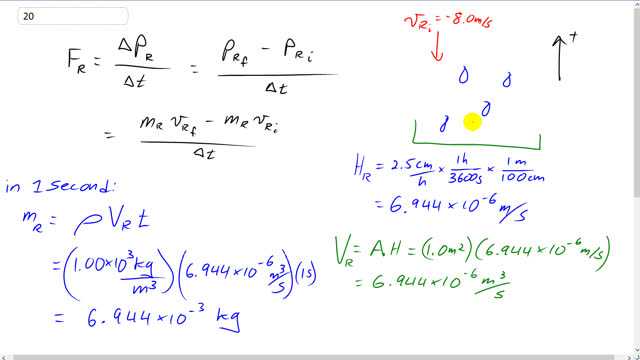
Rain is falling at the rate of 2.5 cm/h and accumulates in a pan. If the raindrops hit at 8.0 m/s, estimate the force on the bottom of a - pan due to the impacting rain which we assume does not rebound. Water has a mass of .

In order to watch this solution you need to have a subscription.
This is Giancoli Answers with Mr. Dychko. We'll figure out the force on the pan due to the rain by calculating the force on the rain due to the pan because these are Newton's third law pairs, they are exerting the same force on each other— same magnitude force but opposite direction. So let's just talk about the rain then; the force on the rain will be the change in momentum of the rain drops divided by time and so that's final momentum of the rain minus initial momentum of the rain. The rain comes to a stop and does not rebound so the final velocity is zero so there's no final momentum in other words and so the force on the rain due to the pan is gonna be negative mass of the rain that's deposited within the pan times the initial velocity of the rain which is negative 8.0 meters per second taking up to be the positive direction and then we'll divide that by some amount of time which as it turns out, we'll just choose to be 1 second but we'll get to that in a second. So let's figure out what this 2.50 centimeters per hour means; that is the amount of height of rain that accumulates per time. So after an hour, the pan will have, you know, it starts to empty and after an hour it will have 2.50 centimeters depth of rain in it and we are going to use that number to figure out what is the rate of water volume added to this pan. Well first we are gonna convert this rate of height increase of the water into meters per second so that it works nicely with our other calculations that we are gonna do. So we'll take this 2.50 centimeters per hour and multiply by 1 hour for every 3600 seconds and then times by 1 meter for every 100 centimeters and we are left with meters per second, 6.944 times 10 to the minus 6 increase in height of that many meters every second. And then let's turn this into a volume by multiplying by the area of the pan which is a nice convenient 1.0 meters squared we are told. So this works out to 6.944 times 10 to the minus 6 cubic meters of water added to the pan every second. And then we'll turn that into a mass that we can use in this formula by deciding on some arbitrary amount of time and we'll choose a convenient 1 second— we can choose any time we like here— and the density of water is 1 times 10 to the 3 kilograms for every cubic meter and we now know how many cubic meters are deposited per second multiplied by a second and we get this many kilograms, 6.944 times 10 to the minus 3 kilograms. So we can plug that number in for the mass of the rain if we choose the time to be 1 second. And so we get negative 6.944 times 10 to the minus 3 kilograms of rain put into the pan minus 8.0 meters per second—its initial velocity— and divide by 1 second and that gives us this force and then that's the force on the rain due to the pan and it's directed upwards because it's stopping the rain from its initially downward velocity. And the force on the pan due to the rain is in the opposite direction, equal magnitude, and it's negative 0.056 newtons because the force on the pan due to the rain is downwards.